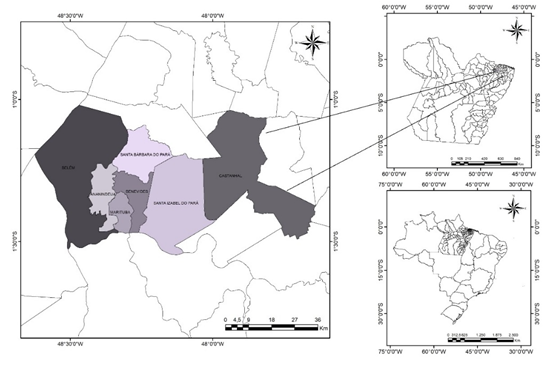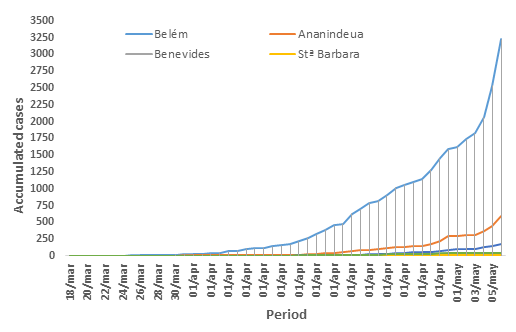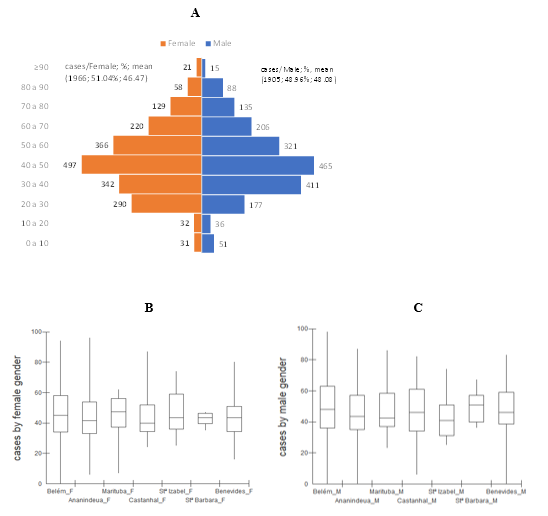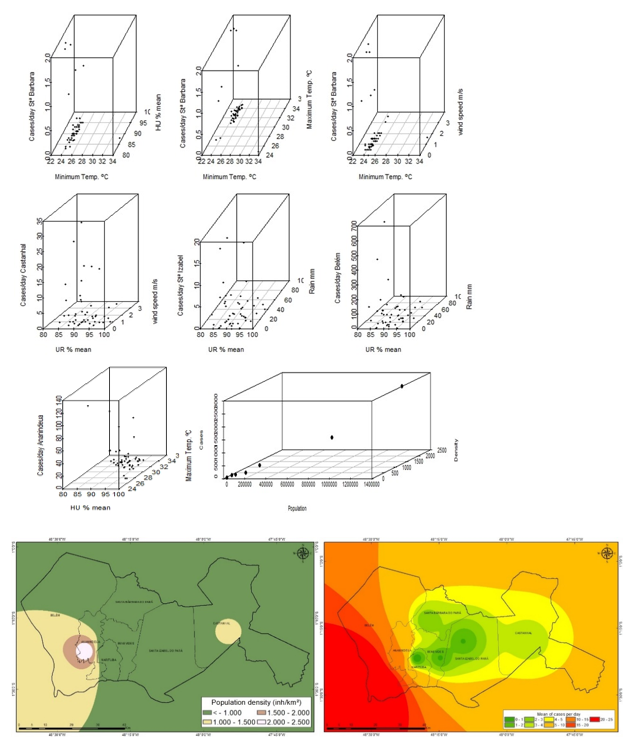Correlation between Meteorological Factors and SARS-CoV-2 Infection in Belém Metropolitan Region
Félix Lélis da Silva1, 2, Maryjane Diniz A. Gomes1, 2, Samio Costa de Sousa3, Marcos Francisco Serafim de Souza4, Nathany Braga Santos1, 2, Alexandre da Trindade Lélis1, 2, Bosco Silveira Brito1, 2, Javier Dias Pita1, 2, Klewton Adriano Oliveira Pinheiro1, 2, Gabriel Lélis P. da Silva5
1Federal Institute of Science and Technology of Pará - IFPA
2Research Group on Experimentation, Modeling, and Biosystems Management – GEMAbio
3Brazilian Institute of Geography and Statistics
4Language, Culture, Technology, and Inclusion Research Group - Licti/IFPA
5Central University of Paraguay - UCP, Medicine undergraduate student
*Corresponding Author: Félix Lélis da Silva, Research Group on Experimentation, Modeling, and Biosystems Management – GEMAbio.
Received: 07 November 2023 Accepted: 16 November 2023 Published: 27 December 2023
Article Information
Citation: Félix Lélis da Silva, Maryjane Diniz A. Gomes, Samio Costa de Sousa, Marcos Francisco Serafim de Souza, Nathany Braga Santos, Alexandre da Trindade Lélis, Bosco da Silveira Brito, Javier Dias Pita, Klewton Adriano Oliveira Pinheiro, Gabriel Lélis P. da Silva. Correlation between Meteorological Factors and SARS-CoV-2 Infection in Belém Metropolitan Region. Archives of Microbiology and Immunology. 7 (2023): 498-508.
View / Download Pdf Share at FacebookAbstract
Many factors may influence the spread of viruses and respiratory infections. Studies have suggested a direct relationship between environmental factors and population density with COVID-19 cases. This work aims to analyze meteorological and demographic variables with COVID-19 cases in regions of subtropical climate in Brazil through correlational study and Krigagem. The results suggest that population and demographic density (inh./km2) are risk factors for SAR-Cov-2 spread and the increased records of daily COVID-19 cases. The distribution of cases according to age group presented a similarity between men and women. Relative humidity (RH) (%), average temperature (ºC), minimum temperature (ºC), maximum temperature (ºC), wind speed (m/s), and daily rainfall (mm) showed negative relationships with COVID-19 cases in regions of humid equatorial climate. Analysis between combinations of environmental factors (wind, temperature, and RH) is fundamental to understand the dynamics of SARS-Cov-2 in the environment. The northern region of Brazil presents low wind speed, high temperatures, and high RH. The combination of such environmental factors reduces the transmission process by hindering the virus movement in the environment. The transmission of SARS-CoV-2 in this region occurs through fluids in the air between person-to-person and by contact between objects-to-person. Therefore, strategic public policies to combat the pandemic must consider the regional environmental factors and control and/or block people’s transit.
Keywords
Environmental factors, Demography, Epidemiology, Coronavirus
Environmental factors articles, Demography articles, Epidemiology articles, Coronavirus articles
Article Details
1. Introduction
The outbreak of the disease caused by the new coronavirus established a worldwide public health emergency. Due to its high spread internationally, the World Health Organization declared COVID-19 a pandemic [1]. COVID-19 is a viral infection that causes severe acute respiratory syndrome and can cause progressive respiratory failure and death [2]. Wuhan, China, was considered the first metropolitan region to be the center of the epidemic in December 2019 [3-4]. Studies infer that several environmental factors contributed to the spread of the infection in the region [5-7]. The transmission factors of a viral disease are variable. The virus spread is associated with environmental factors (temperature, wind speed, and relative humidity), population density, organization and efficiency of the health sector, biological characteristics of the virus, incubation period, and effects on infected and susceptible people [3]. Meteorological factors play an essential role in SARS-Cov-2 spread. Low temperatures and relative humidity favored the virus’s transmission in China, a country with climatic diversity [6].
The transmission rate of COVID-19 has low sensitivity to changes in ambient temperature and high sensitivity to population size [8]. Studies have suggested that temperature contributes to COVID-19 [9] and acts as an indicator of SARS-COV-2 transmission. The COVID-19 incidence presents different dynamics in temperature variations in the region. Thus, the climatic and demographic characteristics of the region must be considered in the analysis of the SARS-COV-2 spread associated with environmental factors [10]. Although 90% of COVID-19 cases have been reported in countries with a temperature range of 3 to 17 °C [11], SARS-CoV-2 can survive for several days in plastics and metals at moderate temperatures (between 21 and 23 °C) and RH of 40% [12]. This fact suggests a direct relationship between temperature, humidity, air pollutants, the environment, and SARS-CoV-2 spread. None evidence supports the reduction of COVID-19 cases in hot climates [13] . However, studies suggest that temperature influences influenza cases in tropical regions [14]. Also, environmental factors influence the spatial distribution dynamics of infectious diseases [15]. These results provide information for public policymakers in regions with different climatic conditions.
Studies must assess the impact of such environmental factors in COVID-19 transmission in different regions throughout the pandemic. Researchers estimate that climatic variables explain 18% of the variation in the disease transmission period, and 82% are related to containment measures, health policies, population density, transport, or cultural aspects [16]. In the Americas, the number of infected people has evolved rapidly, with more than 1.5 million cases and 50 thousand deaths in the period of this study [17]. Brazil stands out as the second country in incidence and mortality rates in the Americas region [18]). Countries such as Brazil, Mexico, Pakistan, the Philippines, and South Africa are vulnerable to the SARS-CoV-2 spread [19]. Researchers suggest the possibility of an unprecedented advance in infections and mortality in more impoverished regions in tropical and subtropical countries. Brazil presents a great climatic diversity and regions with high demographic densities combined with low human development levels. In Latin America, Brazil has shown an increase in records of cases and deaths due to COVID-19, classifying the country as the new pandemic epicenter for SARS-CoV-2 by the World Health Organization. The following questions are made:
- Do the cases of COVID-19 present a sex/gender imbalance in the Belém Metropolitan Region (BMR)?
- Are meteorological variables risk factors for advancing the pandemic in the region of the Pará State, Northern Brazil?
- Which environmental factors are correlated with COVID-19 cases to 5% significance in the region?
- Can high temperatures and RH reduces the SARS-Cov-2 outbreak and the records of new COVID-19 cases in the region?
- Can the beginning of the less rainy period in the Amazon region reduce COVID-19 cases?
- What are the considerations for regions with similar climatic behavior?
2. Materials & Methods
Epidemiological and correlation analyses were performed on the demographic characteristics of the infected diagnosed individuals. The variables evaluated were: sex/gender, age group, population, and demographic density. Subsequently, the correlation between environmental variables such as average temperature (ºC), minimum temperature (ºC), maximum temperature (ºC), relative humidity (%), rainfall (mm), and wind speed (m/s) [20] and the records of daily new COVID-19 cases [21].
2.1 Study area
The present epidemiological study was carried out in diagnosed COVID-19 cases in the seven municipalities belonging to the Belém Metropolitan Region (BMR), Pará, Brazil (Fig.1).
BMR presents a humid equatorial climate, a high population number (around 2,275,032 inhabitants), and diverse demographic density. Its municipal regions present a subtropical climate with wide variations in temperature and high rainfall, distributed over two seasons (more and less rainy). The months between June and December are considered the rainiest months in the Amazon [22-23]. BMR is composed of seven municipalities: Belém, Ananindeua, Marituba, Benevides, Castanhal, Santa Barbara do Pará, and Santa Izabel do Pará [24]. The relative humidity (%) ranged between 80 to 100% in the regions throughout the study period, with an average of 90.3%. The temperature ranged between 24.7 to 34.8 ºC, daily rainfall of 0 to 97.8 mm, and the recorded wind speed ranged between 0 to 3,601 m/s [20].
2.2 Data collection
The collection period ranged from March 18, 2020, to May 6, 2020, which preceded the implementation of the Lockdown Regime. Data on COVID-19 cases recorded in the BMR were obtained from the website of the Ministry of Health of Brazil [21] and the Health Department of the Pará State [25]. Meteorological data were obtained from weather stations located in Belém, Cametá, Breves, Castanhal, Tracuateua, and Tucurui [20]. Figure 2 shows the epidemiological situation (on May 5, 2020) in the BMR. Although the first COVID-19 case was reported in the world in late December 2019 [26-3], the first case in Brazil was reported on February 26, 2020. In Belém, State of Pará, Northern Brazil, a 37-year-old man was the first case notified on March 18, 2020, exactly 23 days after the first case recorded in the country [25].
2.3 Statistical analysis
The descriptive analyzes of the variables were expressed as mean and number (%). Cases without identification for age and gender were imputed. The proportions and mean between gender were analyzed using the Chi-square test for adherence and the independent t-test considering homogeneity of variance of the data with a significance alpha level of 5%. The distribution of cases within genders was assessed using boxplot diagrams. The occurrences of cases and the average age of the infected were analyzed using the Chi-square test and the independent t-test. The correlations between the number of cases and environmental variables were analyzed using the Spearman test. Spearman’s non-parametric test was applied due to the monotonic relationship between ordinal variables and non-compliance with the assumption of normality. It was used to assess the association between the number of COVID-19 cases and environmental factors. Spearman’s coefficient (Eq.1) was calculated according to [26].

Where: is the Spearman coefficient, n the number of alternatives, and di represents the difference between the rows of the corresponding variables.
For results interpretation, the magnitude of the correlations followed the classification: correlation coefficient rho <0.4 implies a weak correlation, between 0.4 ≤ rho <0.5 moderate correlation, and rho ≥ 0.5 a strong correlation between the variables evaluated [27]. The maps of temperature, relative humidity, rainfall, and the number of cases were structured using the Kriging spatial interpolation algorithm.
3. Results and Discussions
This section presents descriptive epidemiological and demographic analysis, proportional analysis (Chi-square test) for the occurrence of cases between sex/gender, and parametric analysis (t-test) to assess the age factor within the sex/gender of those infected. Also, a simple and multiple correlational analysis between meteorological variables and COVID-19 cases is demonstrated.
3.1 Epidemiological and demographic analyzes
Between March 18, 2020, to May 6, 2020, around 3969 cases were reported in the BMR by the Health Department of the Pará State. Of these, 1986 (51.04%) were women, and 1905 (48.96%) were men. The men’s average age was 48.11 ± 17.94 years old with relative variability of CV= 37.29%, and women’s average age was 46.51 ± 17.45 years old and CV= 37.53%. Of these, 16 cases presented no notification regarding sex/gender, and 62 lacked the infected person’s age. The occurrence of cases by gender/sex in the municipalities of BMR showed that women were the most affected in Ananindeua (54.9%), Belém (51.2%), and Santa Izabel (51.5%) throughout the study period. Opposite results were obtained for sex/gender, with most infections recorded in 66% of men and 44% in women [28]. However, the recorded cases in men were proportionally higher in the municipalities of Marituba (67.4%), Benevides (63.6%), Castanhal (60.9%), and Santa Bárbara (55.6%). Table 1 presents the number of COVID-19 cases in the municipality regions in the period. Epidemiological results indicate that most records occurred in the State capital, Belém, with 3223 (76.87%) cases, followed by Ananindeua (591; 14.09%), Castanhal (176; 4.20%), Santa Izabel (103; 2.46%), Marituba (47; 1.12%), Benevides (44; 1.05%), and Santa Barbara (9; 0.21%). Belém has the largest population (1,393,399 inhabitants) and a population density of 1,313.26 inhabitants per square kilometer. The region was the dissemination center for the SARS-CoV-2 virus through community transmission to neighboring municipalities in BMR and other State’s regions.
Table 1: Relational behavior of demographics and new cases of COVID-19 recorded in Belém Metropolitan Region
Note:in the analyzes (Chi-square and mean test) 78 cases were disregarded due to the lack of identification in the records for gender/sex and age of the infected person
The city of Belém showed the highest number of infected people among the seven municipalities belonging to the BMR with 2996 cases (65.9%), followed by Ananindeua (517; 14.1%), and Castanhal (156; 4.2%). These municipalities are located on the margins of Highway BR 316, which connects Belém to the other cities in the country and several municipalities of Pará State.
3.2 Non-parametric and parametric analyzes
In Table 1, the Spearman test (rho = 0.987) was applied to assess the relationship between population and density in the occurrence of COVID-19 cases. The results showed a high positive correlation between the number of recorded cases and the population of these regions. However, demographic density and cases of infection by COVID-19 showed a moderate correlation (rho = 0.393). Similar results were obtained in urban centers with large agglomerations closely linked to high infections by COVID-19 [26].
In table 1, the Chi-square test assessed the difference between cases by gender in the region’s municipalities. We demonstrated a significant proportional difference of 5% between those infected by gender (male and female) in Ananindeua, Castanhal, and Marituba. In the other regions, no proportional difference was observed, results supported by Figure 3A. These results showed that sex/gender are independent of the number of registered cases of SARS-CoV-2 infections. Therefore, sex/gender is not a risk factor for COVID-19. The Independent t-test was not significant at 5% when comparing the average age and gender of those affected by the virus within the municipalities. These tests demonstrated no difference in the distribution behavior of cases by age group between men and women. This fact can be proven by comparing the variation coefficients (CV%) of the ages (Table 1) and Figures 3B and 3C. Our results show that the age group is not a risk factor for COVID-19 within the municipalities belonging to the BMR. However, the economically active population from 20 to 60 years old is the most affected by the disease.
3.3 Simple correlational analysis between meteorological factors and COVID-19
Meteorological variables are among the leading causes that affect infectious diseases, and viruses spread. Analyzing Spearman’s correlation coefficients with the respective levels of probability of the test (p-value), we observed that environmental factors such as RH, average temperature, minimum temperature, maximum temperature, rainfall, and wind speed presented a negative correlation with the number of COVID-19 cases in the municipalities belonging to BMR (Table 2).
Table 2: Correlation between environmental factors and records of COVID-19 cases in the municipalities of Belém Metropolitan Region, through Spearman’s test.
RH presented a negative non-significant correlation with the number of COVID-19 cases in Belém, Ananindeua, and Santa Barbara. However, the number of COVID-19 cases did not correlate with RH in the municipality of Benevides. The region of Santa Izabel and Castanhal showed a significant negative correlation at 1% (p = 0.005) with the daily record of infections. Similar negative correlations for COVID-19 cases and RH were obtained in Turkey [26]. We infer that the record of the daily cases of infected people in these municipalities is significantly associated with RH. The records also demonstrated that an increase in RH implies a reduction in cases of COVID-19 in these locations. Studies suggest that high RH decreases the viability of the SARS-CoV-2, confirming our results [29]. Also, the RH is positively correlated with the rainfall factor and negatively correlated with the average temperature and the maximum temperature in the study’s region in the evaluated period. The minimum temperature recorded in the region negatively correlates with the number of COVID-19 cases in Ananindeua, Benevides, Santa Barbara, and Marituba. Despite the weak magnitude of the correlation, the minimum temperature (ºC) is significantly associated with daily COVID-19 cases in the Santa Barbara region. Similar results were observed for the spread of cases of SARS virus in Beijing and Hong Kong regions and in Turkey, concluding that the temperature is closely related, and at high temperatures, a reduction in case records was observed [26; 30]. The average temperatures recorded in Ananindeua, Benevides, and Santa Barbara showed a negative correlation with the records of COVID-19 cases in these regions. However, Spearman’s test showed no evidence to confirm the significance of such relationships. Studies on climate change patterns over the expansion of COVID-19 cases in New York suggest that the average and minimum temperatures in the region were correlated with the case records [31]. Similar results were observed in mainland China to those observed in BMR [32], where negative correlations were found between temperatures and relative humidity in COVID-19 cases. The maximum temperature showed a negative correlation with the number of SARS-CoV-2 infections in Belém, Ananindeua, Benevides, and Santa Barbara. However, no statistical evidence suggests that this correlation occurs significantly. The same negative linear correlation between temperatures and the number of confirmed cases was obtained in Brazilian cities [33]. However, a study identified a correlation between the increase in COVID-19 cases at temperatures above 10 ºC [32]. High temperatures and high humidity reduce the transmission of COVID-19 [34]. The climate is an essential factor in determining the incidence rate of COVID-19, and the temperature and its variations are correlated with the infection records [35]. Regarding the environmental factor rainfall, the results showed a negative correlation with COVID-19 cases in Belém, Santa Barbara, and Castanhal. However, this association is not statistically significant. Another study correlated the rainfall with COVID-19 cases [36]. Wind speed in Santa Barbara showed a negative correlation with daily records of COVID-19. However, the wind speed was positively correlated with COVID-19 cases in the Castanhal region during the study period. Thus, the higher the wind speed in the region, the greater the SARS-CoV-2 spread. Although these results were not significant at 5% using the Spearman rho test, different results were found in Turkey. The author demonstrated a positive correlation between COVID-19 cases and the region’s wind speed (m/s) [26].
3.4 Multiple correlational analysis between meteorological factors and COVID-19 cases
For multiple associations between temperature variations (minimum and maximum) and daily records of COVID-19, the lowest mean of daily records of COVID-19 was observed in the municipality of Santa Barbara in temperatures between 24 to 34 ºC, minimum temperatures of 24 ºC combined with RH between 85 to 95%, and minimum temperatures of 24ºC and wind speed between 0.5 to 2.0 m/s (Fig.3).
Our results suggest that low-density regions (inh./km2) have lower records of COVID-19. However, urban centers with a population density higher than 150 inhabitants per square kilometer presented the highest number of infections in the region. Significant negative correlations were found between the number of cases and relative humidity in Castanhal and Santa Izabel (Table 2). Multiple spatial correlation analysis was performed considering RH as the main factor for these regions. Associations between RH/wind speed and RH/rainfall suggest that when the RH is between 85 to 100% and the wind speed is between 0 to 1 m/s, lower COVID-19 cases were recorded in Castanhal. However, wind speed higher than 2 m/s and daily rainfall above 60 mm lead to the highest COVID-19 cases. Similar lower COVID-19 cases were found in Santa Izabel when the RH varied between 85 to 100% and rainfall between 0 to 30 mm average/day. In Belém, the combination of RH between 80 to 95% and daily rainfall between 0 to 30 mm lead to a reduced number of SARS-CoV-2 cases. The RH lower than 85% and daily rainfall higher than 60 mm favored COVID-19 cases. The combination of RH between 80 to 95% and temperature between 26 to 32 ºC resulted in the lowest number of SARS-CoV-2 cases in Ananindeua (Fig.4).
Many factors may influence the spread of viruses and respiratory infections. Thus, correlational studies support the health policies development to combat the disease and the records of new cases. Studies have suggested a relationship between environmental factors and COVID-19 cases. In this study, the population and demographic density (inh./km2) of a region determine the daily records of COVID-19; the distribution of cases according to the age group is similar between men and women. Environmental factors such as RH (%), average temperature (ºC), minimum temperature (ºC), maximum temperature (ºC), wind speed (m/s), and daily rainfall (mm/day) have a negative relationship with COVID-19 cases in cities with humid equatorial climate in Northern Brazil. In this region, a low wind speed and high RH are observed annually. Combining these environmental factors reduces the virus transmission process as they hinder the virus movement in the environment. Thus, the transmission in the region occurs directly through fluids between person-to-person and objects-to-person. Therefore, public policies focused on controlling the pandemic must consider the environmental factors of the regions involved. Studies showed that ambient temperature and its correlation with RH are important factors in transmitting the SARS-CoV-2 virus, and mortality from COVID-19 [7;37]. Therefore, the correlation of these environmental factors in regions with low RH, high wind speed, high temperatures, and low demographic density is essential to understand the behavior of these environmental factors on the virus transmission when the population factor is irrelevant. Finally, attention is drawn to countries such as Peru (3rd), Ecuador (7th), Bolivia (12th), Honduras (13th), and Haiti (17th), which are rising in the ranking of COVID-19 cases in the Americas. Such countries present tropical climates similar to the region of the present study. Particularly for Haiti, in Central America, which presents a considerable demographic density of 361.5 inhabitants/km2, low Human Development Index (HDI = 0.404), and life expectancy of 60 years. Also, Honduras presenting low RH, low temperature, and moderate wind speed. The combination of these meteorological factors favors SARS-CoV-2 spread, as reported in this study. In South America, Ecuador presented an increasing number of COVID-19 cases. This is a concerning fact because this country presents low temperatures, low relative humidity, and mild wind speed, which combined may favor the SARS-Cov-2 spread in Ecuador.
4. Conclusion
The COVID-19 cases in the BMR showed similarities concerning the sex/gender and age group of those infected. Regarding the environmental factors and the dynamics of daily cases, there is a low correlation between the factors RH (%), average temperature (ºC), minimum temperature (ºC), maximum temperature (ºC), wind speed (m/s), and rainfall (mm/day) in COVID-19 cases. However, the minimum temperature (ºC) factor showed a significant negative correlation at 5% with the records of COVID-19 in Santa Barbara. This suggests a reduction in SARS-CoV-2 infections with increasing temperature. Thus, it is expected that temperature is not a risk factor for infections in warmer periods in the region. Relative humidity in Ananindeua and Castanhal showed a negative and relevant correlation with COVID-19 cases, suggesting that RH is not a risk factor for SARS-CoV-2 spread in the region where RH is regularly elevated. In the Northern region of Brazil, higher temperatures correspond to the period from June to December. Despite the low negative correlation with higher temperatures, they were not statistically significant to indicate that they reduce contamination and the records of daily new cases. Also, there is no evidence that high temperatures are a risk factor for increasing COVID-19 cases. However, the significant negative correlation between the number of cases and minimum temperature shows that high temperatures in the Northern region will not favor the progress of SARS-CoV-2.
The multiple correlations of variables show that high relative humidity combined with rainfall, low wind speed, and temperature above 26 °C favors a lower incidence of COVID-19 cases in the studied region. However, low relative humidity increases the number of cases and may be related to the drier environment. As the RH lowers, the environment becomes drier and facilitates the air transport of particles in the environment, enabling the transmission of the SARS-CoV-2 virus. In the Northern region, a low wind speed and high RH are observed annually. These combined environmental factors decrease the virus transmission process by hindering their movement in the environment, suggesting that the transmission of the virus in BMR occurs directly through fluids between person-to-person and objects-to-person. Countries such as Haiti and Honduras in Central America, and Ecuador in South America are regions that must create and strengthen containment and public health policies aimed at combating pandemics and treating infected people, as they are regions that have good meteorological combinations for SARS -CoV-2 spread as identified in our results.
Conflicts of Interest Statement
The authors declare that there are no conflicts of interest.
Acknowledgements
This study was supported by the Research Group on Experimentation, Modeling, and Biosystems Management - GEMAbio.
References
- World Health Organization. Coronavirus disease (COVID-19) outbreak situation (2020).
- Coccia M. Factors determining the diffusion of COVID-19 and suggested strategy to prevent future accelerated viral infectivity similar to COVID. Science of the Total Environment (2020): 729.
- Zhou P, Yang X, Wang X, et al. A pneumonia outbreak associated with a new coronavirus of probable bat origin 579 (2020): 270-273.
- Wang L, Li J, Guo S, Xie N, Yao L, Cao Y, et al. Real-time estimation and prediction of mortality caused by COVID-19 with patient information based algorithm. Sci. Total Environ (2020): 138394.
- Bhattacharjee S, Statistical investigation of relationship between spread of coronavirus disease (COVID-19) and environmental factors based on study of four mostly affected places of China and five mostly affected places of Italy (2020): 11277.
- Liu j, Zhou J, Yao J, Zhang X, Li L, Xu X, et al. Impact of meteorological factors on the COVID-19 transmission: A multicity study in China. Science of the Total Environment (2020): 726.
- Ma Y, Zhao Y, Liu J, He X, Wang B, Fu S, et al. Effects of temperature variation and humidity on the death of COVID-19 in Wuhan, China. Sci. Total Environ 724 (2020): 138226.
- Jahangiri M, Jahangiri, Milad, Najafgholipour M. The sensitivity and specificity analyses of ambient temperature and population size on the transmission rate of the novel coronavirus (COVID-19) in different provinces of Iran 728 (2020).
- Shi P, Dong Y, Yan H, Zhao C, Li X, Liu W, et al. Impact of temperature on the dynamics of the COVID-19 outbreak in China. Science of the Total Environment 728 (2020): 138890.
- Tan J, Mu L, Huang J, et al. An initial investigation of the association between the SARS outbreak and weather: with the view of the environmental temperature and its variation. J. Epidemiol. Community Health 59 (2005): 186-192.
- Bukhari Q, Jameel Y. Will Coronavirus Pandemic Diminish by Summer (2020).
- Van Doremalen N, Bushmaker T, Morris DH, Holbrook MG, Gamble A, Williamson BN, et al. Aerosol and surface stability of SARS-CoV-2 as compared with SARS-CoV-1, N Engl J Med (2020).
- Lal P, Kumar A, Kumar S, Kumari S, Saikia P, Dayanandan A, et al. The dark cloud with a silver lining: Assessing the impact of the SARS COVID-19 pandemic on the global environment. Science of the Environment 732 (2020).
- Tamerius JD, Shaman J, Alonso WJ, et al. Environmental predictors of seasonal influenza epidemics across temperate and tropical climates. PLoS Pathog 9 (2013): e1003194.
- Lemaitre J, Pasetto D, Perez-Saez J, et al. Rainfall as a driver of epidemic cholera: comparative model assessments of the effect of intra-seasonal precipitation events. Acta Trop 190 (2019): 235-243.
- Oliveiros B, Caramelo L, Ferreira NC, et al. Role of Temperature and humidity in the modulation of the doubling time of COVID-19 Cases (2020).
- Pan American Health Organization. Information sheet-COVID-19.
- World health statistics 2019: monitoring health for the SDGs, sustainable development goals. Geneva: World Health Organization (2019).
- Hotez PJ, Bottazzi ME, Singh SK, Brindley PJ, Kamhawi S. Will COVID-19 become the next neglected tropical disease? PLoS Negl Trop Dis 14 (2020): e0008271.
- National Meteorological Institute of Brazil. Climatic data (2020).
- Ministry of Health. Accumulated COVID-19 cases and deaths by confirmation date (2020).
- Souza Filho JDC, Ribeiro A, Costa MH, Cohen JCP. Mechanisms to control the seasonal variation of transpiration in a tropical forest in northeastern Amazonia. Acta Amazônica 35 (2005): 223-229.
- Moraes BC, Costa JMN, Costa ACL, Costa MH. Spatial and temporal variation of precipitation in the state of Pará. Acta Amazon 35 (2005): 207-217.
- Brazilian Institute of Geography and Statistics - BIGS. Populations (2020).
- Pará. Pará State Heart Secretariat (PSHS). Coronavírus in Pará (2020).
- Sahin M. Impact of weather on COVID-19 pandemic in Turkey. Science of the Total Environment 720 (2020).
- Hulley SB, Cummings SR, Browner WS, Grady D, Hearst N, Newman TB. Delineando a pesquisa clínica: uma abordagem epidemiológica. 2a Ed. Porto Alegre: Editora Artmed (2003).
- Nikpouraghdam et al. Epidemiological characteristics of coronavirus disease (COVID-19) patients in IRAN: A single center study (2020).
- Chan JFW, Yuan S, Kok KH, To KKW, Chu H, Yang J, et al. A familial cluster of pneumonia associated with the 2019 novel coronavirus indicating person-to-person transmission: a study of a family cluster. Lancet 395 (2020): 514-523.
- Bi P, Wang J, Hiller JE. Weather: driving force behind the transmission of severe acute respiratory syndrome in China? Intern. Med J 37 (2007): 550-554.
- Shi P, Dong Y, Yan H, Li X, Zhao C, Liu W, et al. The Impact of Temperature and Absolute Humidity on the Coronavirus Disease 2019 (COVID-19) Outbreak - Evidence from China. medRxiv (2020b).
- Bashir MF, Ma B, Bila L, Komal B, Bashir MA, Tan D, et al, Correlation between climate indicators and COVID-19 pandemic in New York, USA. Science of the Total Environment 728 (2020): 138835.
- Prata DN, Rodrigues W, Bermejo PH. Temperature significantly changes COVID-19 transmission in (sub) tropical cities of Brazil. Science of the Total Environment 729 (2020): 138862.
- Chatziprodromidou TA, and Vantarakis A. COVID-19 and Environmental factors. A PRISMA-compliant systematic review. medRxiv (2020).
- Tosepu R, Gunawan J, Effendy DS, Lestari H, Bahar H, Asfian P. Correlation between weather and Covid-19 pandemic in Jakarta, Indonesia. Sci. Total Environ 725 (2020): 138436.
- Menebo MM. Temperature and precipitation associate with Covid-19 new daily cases: A correlation study between weather and Covid-19 pandemic in Oslo, Norway. Science of the Total Environment 737 (2020): 139659.
- Zhu N, Zhang D, Wang W, et al A novel coronavirus from patients with pneumonia in China. 2019 N Engl J Med (2020).






 Impact Factor: * 3.5
Impact Factor: * 3.5 Acceptance Rate: 71.36%
Acceptance Rate: 71.36%  Time to first decision: 10.4 days
Time to first decision: 10.4 days  Time from article received to acceptance: 2-3 weeks
Time from article received to acceptance: 2-3 weeks 
